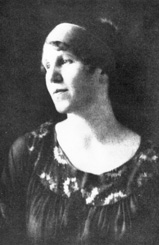The Gurdjieff Legacy Foundation Archives
Julia Osipovna Ostrowska (1890?–1926)

Julia Osipovna Ostrowska was born in Poland around 1890. She married Gurdjieff in 1912. She was 22 and he was 40. Gurdjieff said that she was an "'old soul' who had lived many lives." Little is known about her personal history, some saying she had been a countess, others a poor woman from the streets. Known for her dedication, poise and authority, she was his principal dancer in The Struggle of the Magicians. When the Institute at the Prieuré opened in 1922, she was known as Mme Ostrowska.1 She was in charge of the kitchens and housekeeping at the Institute, as well as continuing to dance the lead role of the Priestess in the Sacred Dances. In 1924, when Gurdjieff was seriously injured in a car accident, she and Gurdjieff's mother helped nurse him back to health. Soon afterwards she contracted terminal cancer. Mme Ostrowska died on June 26, 1926, and was buried in Avon, France, beneath the large dolmen that faces Gurdjieff's mother's grave.
She was given radiotherapy treatment, but her condition worsened. Gurdjieff worked tirelessly in his efforts to keep her alive, telling the young Fritz Peters:
"If she alone, already she be long time dead. I keep alive, make stay alive, with my strength; very difficult thing. But also very important—this most important moment in life for her. She live many lives, is very old soul; she now have possibility ascend to other world. But sickness come and make more difficult, make impossible for her to do this thing alone. If can keep alive few months more will not have to come back and live this life again."2
Said Gurdjieff of his wife's illness in his Third Series, Life Is Real Only Then, When 'I Am':
"I became aware, and after some days of unnoticed observation definitely established the fact, that the terrible illness of my sincerely loved wife, owing to the pause in my special treatment and also to her forgetfulness of self in ministering to me during my illness, had been so neglected that by this time there was already a question as to the possibility of curing her."3
And later in the book he spoke of remembering her after her death:
It happened that I sat on the very bench on which it had been my habit, during the first year of my writing, often to sit and work.
At that time there frequently used to come and sit down by me on this bench, on each side of me, two near beings, the only ones close to my inner world.
One of them always adored by me was my old mother and the other, my uniquely and sincerely beloved wife.
At the present time both of these women, uniquely nearest to my inner world, peacefully lie forever side by side in a cemetery which is for them as well as for me in an entirely strange country.4
Usually when my mother left her home...and proceeded in my direction there would approach from the house called "Le Prieuré," my wife....to the bowed posture of the second I was quite unable to reconcile myself; each time when I noticed it there arose in me a feeling of revolt and my heart pounded like that of a balking horse.
For it was only a trifling eighteen years earlier that, thanks to this now stooped and sallow-faced woman and her accidental presence in the place where the awarding of prizes for beauty was going on in St. Petersburg, the famous Lena Cavalieri [a diva renowned for her beauty], then in the bloom of her youth, was deprived of the first prize.5
Fritz Peters gives an extensive description of Mme Ostrowska in his book Boyhood with Gurdjieff:
She was a very tall, big-boned, handsome woman, and she seemed to be ever-present, moving almost silently along the corridors of the buildings, supervising the operation of the kitchens, the laundry rooms and the general housekeeping work. I never knew exactly how much, or what, authority she had. On the few occasions when she actually said anything to us, which were rare, there was no question in our minds but that her word was law. I remember being particularly fascinated by the way she moved; she walked without any perceptible movement of her head and without the slightest jerkiness in her movements; she was never hurried, but at the same time she worked at incredible speed; every movement she made in whatever she was doing was absolutely essential to that particular activity.6
Katherine Mansfield was very taken with Mme Ostrowska. She said of her performance as the Priestess:
If only I could have just a little place in that group, if I could sit in front of Mrs. O. with my arms crossed on my breast, I would listen to the beautiful music. I would feel Mrs. O's marvelous arms raised above me in prayer. How grateful I could be for it.7
Notes
1. James Moore, Gurdjieff: A Biography (Shaftesbury, Dorset: Element Books, 1999), 67–68.
2. Fritz Peters, Boyhood with Gurdjieff (Fairfax, CA: Arete Communications, 2006), 91.
3. G. I. Gurdjieff , Life Is Real Only Then, When 'I Am' (London: Penguin Books, 1991), 32–33.
4. Ibid., 36.
5. Ibid., 38.
6. Peters, 87.
7. Moore, 185.